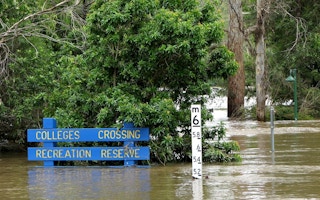For the first time, researchers have linked the catastrophic floods in Australia in the summer of 2010 with global warming.
And they warn that the double hazard of long-term ocean warming and rising atmospheric temperatures makes the risk of extreme rainfall greater in years to come.
In 2010, during a natural cyclic Pacific phenomenon called La Niña, sea surface temperatures in the Indian Ocean and the western Pacific were high, and the air became saturated with moisture.
When the clouds billowed over Queensland, they deposited so much water that 35 people died, 28,000 homes were flooded and 100,000 people were left without electricity. Lake Eyre, a normally dry lakebed in the country’s interior, filled with water.
The economic damage amounted to US $2.38 bn. Altogether so much water fell on the normally arid landscape that global sea levels dropped perceptibly.
Rapid warming
“The sea surface temperatures around Australia during 2010/2011 were on average 0.5°C warmer than they were 60 years ago,” said Caroline Ummenhofer, a physical oceanographer at the Woods Hole Oceanographic Institution in the US. “While many past studies have found a global warming link to heat extremes, this study is one of the first to show how ocean warming can impact a heavy rainfall event.”
She and her Australian colleagues report in the journal Geophysical Research Letters that they had identified the mechanisms that increase the likelihood of extreme rainfall. “Additional ocean warming enhanced onshore moisture transport into Australia and ascent and precipitation over the northeast,” they write.
“Our results highlight the role of long-term ocean warming for modifying rain-producing atmospheric circulation conditions, increasing the likelihood of extreme precipitation for Australia during future La Niña events.”
La Niña is the supposedly cooler little sister of the notorious El Niño, associated with warmer than usual waters in the eastern equatorial Pacific. Researchers havealready warned that it could play a role in future floods: Dr Ummenhofer and her colleagues have looked back in time to find that it has already done so.
Climatologists are normally reluctant to ascribe any one weather event to climate change driven by rising carbon dioxide levels as a consequence of the human combustion of fossil fuels: that is because climate is what people expect, but weather is what happens.
Repeated warnings
But Australian researchers have separately warned of storms ahead as global temperatures rise, and have identified the fingerprint of global warming in record temperatures in the southern continent.
They have also found that human greenhouse gas emissions may be contributing to the sustained droughts that periodically cripple Australia’s agriculture.
But this is the first direct link with any one episode of flooding. One prediction of the Woods Hole team’s modelling experiments is that because of warmer sea surface temperatures, Australia is now three times more likely to experience unprecedented rainfall during a strong La Niña event.
“The additional warming of the oceans has profound impacts on the atmosphere. It increases the amount of moisture in the atmosphere and can intensify rain-producing circulation conditions,” said Matthew England, of the Australian Research Council’s Centre of Excellence for Climate System Science, and a co-author.
“This is why in 2010/11 more moisture was brought onshore along Australia’s east coast. Stronger rising motion over the northeast resulted in higher rainfall, making it more likely for Australia to suffer extreme rainfall conditions during this strong La Niña.”










